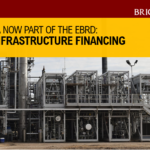Financing A World Scale Green Hydrogen Export Project
Green hydrogen remains a key investment for the energy transition as it holds significant promise to help meet global energy demand while contributing to climate action goals.
However, a recent publication from Oxford Energy asserts that it is anticipated that green hydrogen will require government support for the next 15-20 years and that green hydrogen export projects will have to compete, largely on delivered price, to supply the demand created by the importing government programmes. Efficient project financing, both debt and equity, can play an important part in minimising the cost.
This article by Brickstone, reviews Oxford Energy’s publication on financing a world scale hydrogen export project, highlighting key insights and takeaways.
The Green Hydrogen World
The global green hydrogen market has been forecast by the IEA to grow from almost zero in 2021 to 9- 14 mtpa in 2030 and 125-300 mtpa by 2050. The wide range is due to many uncertainties including: end-user demand which will be, at least initially, largely a function of government policy; competing technologies and the rate at which costs fall, and certification and decisions over which types of low- carbon hydrogen will qualify for government support.
The IEA also projects exports of 12mtpa of low- carbon hydrogen by 2030, of which almost 90 per cent is expected to be green hydrogen and the majority transported as green ammonia.
A very substantial amount of capital will need to be invested in green hydrogen production to meet the 2050 net zero target and a significant proportion of this is expected to be used for export projects. Each green hydrogen import tender is expected to attract many supply bids and achieving the lowest delivered cost will be critical to success. Efficient financing can make an important contribution to minimising this cost.
While necessarily uncertain, it is generally expected that the cost of producing green hydrogen will fall rapidly, as it has for solar and wind power generation. The IEA forecasts that current green hydrogen production costs of USD 3-8/kg will fall to USD 1.3-4.5/kg in 2030 and USD 1.0-3.0/kg by 2050. While some hydrogen projects are competitive at current high fossil fuel prices, at present almost all low- carbon hydrogen projects will require government support (whether by subsidy, other forms of financial support or statutory obligations, or carbon pricing) to attract investment, especially at the rate required to meet net zero targets by 2050.
This is expected to remain the case for at least another 15-20 years in most end-use sectors. Substantial capital will be required to develop this new industry.
The following are key insights from the publication:
According to Oxford’s Energy, green hydrogen is a nascent industry using emerging technologies that needs to grow from almost no production currently to 9 – 14 mtpa in 2030 and up to 300 mtpa by 2050 to meet the IEAs net zero emissions trajectory. The cumulative capital requirement for green hydrogen production to meet these levels is estimated to be up to USD 300 billion by 2030 rising to USD 2,500 billion by 2050. At present, there is an ‘economic gap’ between the cost of producing green hydrogen and the price of the fossil fuel alternatives in all end-use cases.
For a green hydrogen project to secure a long-term offtake (with the associated government support) in what is likely to be a global competitive auction, it will need to offer a very competitive delivered price. In addition to low-cost electricity and a low capital cost, the cost of capital (both debt and equity) will play an important role in reducing the levelized cost, in particular the maintenance of a high level of debt throughout the life of the project.
Lenders will typically look to analogous sectors for precedents. Green hydrogen has many features in common with LNG: they both require the export of an energy product/industry feedstock to a remote market in another jurisdiction and they are both large-scale, complex, and technically challenging industries requiring significant investment by both seller and buyer. Another analogous sector is offshore wind. It is also large scale and, although more advanced, it has until recently been an emerging technology. It is also economically similar, with very limited economic profitability but no expected exposure to commodity prices and most projects will require explicit government support for some years to come.
On the question of what is required for Bankability, it is not possible to be precise about what will be required, with lenders strongly incentivised to participate in energy transition projects and very keen to support the early hydrogen financings and consequently likely to be more flexible than in traditional sectors. However, one can be confident that all lenders will need to be satisfied as to the key risks: Buyer Government Support, Offtake, and Completion.
Experience from offshore wind, initially also very much an emerging technology, suggests that some lenders, at least, will be prepared to accept completion risk if there is a robust underlying framework of EPC and other construction agreements and strong contractual commitments from the buyer or third parties providing critical services such as shipping, receiving facilities or, in the case of a segregated project, renewable power. However, such a non-recourse financing would come at some cost in terms of the time to negotiate the financing, reduced leverage, and greater monitoring and control by the lenders.
Oxford’s Energy envisages three major commercial models – integrated merchant, segregated merchant and integrated tolling. The models reflect those that have been used in the LNG industry. The Tolling model, in particular, could allow a trader to maximise the option value of the project. Subject to PPA terms that mirror the GASPA in the case of a Segregated Merchant model and tolling agreement terms that do not expose the project to volume or price risk, each of the models should be financeable.
Based on experience from the offshore wind industry, lenders will likely be prepared to accept completion risk where the technology is reasonably established – as can probably be argued for green ammonia – and if there is a robust contracting strategy. Less mature technologies, such as liquid hydrogen, would be expected to demonstrate a successful track record of construction and operation before lenders would accept pre-completion exposure. However, this could be addressed in less than five years.
As the learning curve reduces capital costs, the need for government support will reduce and ultimately no longer be required. For offshore wind, it took about 15 years for the first zero-subsidy project to emerge. While some end-use cases might reach break even earlier, it is reasonable to expect that it will take 15-25 years until new green hydrogen projects no longer require government support.
Long-term, fixed price, government supported contracts provide a strong basis for financing and have proven very successful in attracting capital into the emerging offshore wind sector. As that support is removed, investors will be required to accept price risk for an emerging green hydrogen market. This would lead to lower DERs and could slow investment until commercial long-term contracts or a long-term futures market emerge.
Green hydrogen is expected to become, eventually, a global, traded commodity. However, from the first LNG trade in 1969, LNG has taken over 50 years to move from a purely bilateral trade to the widely traded, but not yet fully commoditised, market that it is now. It is worth noting that no LNG financing has been closed to date that was not underpinned by long-term offtake contracts. It is not expected that there will be a globally traded green hydrogen market until the 2040s at the earliest (although regional markets may well develop earlier in the US or NW Europe).
Download the full publication here.






